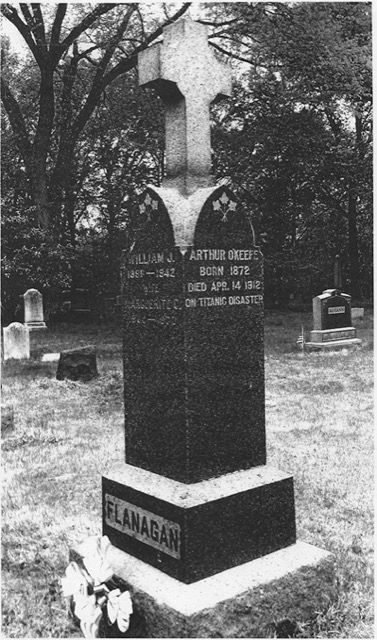
Rahway Resident Sailed on Ill-Fated Titanic
Submitted by Al Shipley, City Historian and Rahway Library Research Consultant
The tragic story of the sinking of the Titanic 110 years ago this month, is familiar to people from all parts of the globe and one that has captivated the interest of generations. No fewer than 150 books and more than two dozen films have recounted the event, attesting to the fact that the disaster evokes universal emotions of human empathy and pathos. The stunning tragedy of the giant liner sparks deeper feelings when there is a closer connection to any one of the doomed passengers. Such is the case with Arthur Keefe, a familiar and popular resident of Rahway’s east section, who perished in the icy waters of the North Sea as the magnificent ship foundered and disappeared beneath the waves.
The White Star liner, Titanic, began her maiden voyage on Wednesday, April 10, 1912 carrying 2,200 passengers and crew members. The size of three football fields in length, it was the largest and most elegant steamship the world had ever known and one can only imagine the feeling of excitement and anticipation as the ship made ready for its eight day journey. Passenger Arthur Keefe was returning to America after spending two months on a business/pleasure trip through England, Wales, Scotland, and Ireland. A bachelor, Keefe lived on Monroe Street with his widowed sister and was known around the city as the “Mayor of East Rahway.” Prior to embarking, he sent postcards to his friends that he would be sailing from Southampton on the Titanic and would arrive in New York Harbor on Wednesday, April 17.
Even though Keefe was traveling as a third-class passenger and was not allowed to enter many of the exclusive first-class areas, his days on the Titanic were more than comfortable and the journey was proving to be an extension of what had been a pleasant vacation. He felt a part of the grand experience simply by walking on the main deck of the “Floating Palace’. His berth was rather Spartan, but as he didn’t spend much time below decks, he found it an adequate space for sleeping. And he would sleep soundly for the first four nights as the vessel rocked gently on the rolling sea.
On the fateful night of Sunday, April 14, Keefe’s life and the lives of every passenger on board would forever be changed. At approximately twenty minutes before midnight, with most in their sleeping quarters, the Titanic, cruising at full speed, scraped the side of an iceberg. Frigid water rushed into the ship setting in motion the events of the unbelievable catastrophe. Few heard or felt the collision and fifteen minutes passed before first-class passengers were stirred from their beds. Most who were made aware of the accident were certain that although damaged, the mighty ship was in no real danger. Third-class passengers did not get word of what had become a serious situation until 12:30 a.m.
Books and movies have told the story of the panic, chaos, confusion, and horror that took place over the next two hours. Of the 2,200 persons on board, 1,500 lives were lost. Stories would come forward that give a terrifying glimpse of the desperate scenes witnessed by survivors including two accounts of the final moments of Arthur Keefe’s life. One survivor reported that as the ship was going down, everyone started jumping off. He saw Keefe, who he recognized from a previous meeting in the third-class dining area, jump. The man followed Keefe over the side. For several deadly minutes they frantically splashed about in the freezing water fighting to stay alive. Providence must have smiled on them as he and Keefe were pulled into a lifeboat. Unfortunately, Keefe died in the arms of his rescuers. His body was dropped back into the water with the hundreds of others whose bodies were becoming eerily silent and still. A second survivor recalled seeing Keefe in his pajamas standing on the main deck just before the ship went down. He recognized Keefe by the bald spot on the back of his head and also by a heavy gold ring he wore on the little finger of his left hand.
In the days following the disaster, the steamer Mackay-Bennett, was sent to the site to retrieve bodies and bring them to Halifax, Nova Scotia for identification and burial or release to their families. By the end of a month-long search, over 300 bodies, or about two tenths of the number who perished, were found. Unrecognizable bodies were buried at sea with religious services.
In Rahway, the full force of the horror was felt in the probable loss of one of its citizens. On April 18, flags throughout the city were placed at half-staff to “mark the city’s part in the grief which has overspread the entire world.” A Solemn Requiem High Mass was celebrated in memory of Keefe on Wednesday, April 24 in St. Mary’s Church.
In late April, Mrs. Margaret O’Brien, Keefe’s sister, traveled to Halifax with hopes of locating and identifying her brother’s remains. Questioning various undertakers, she was told that no one answering her brother’s description had been picked up.
The body of Arthur Keefe was never found. His name was later inscribed on the family monument in St. Mary’s Cemetery.

